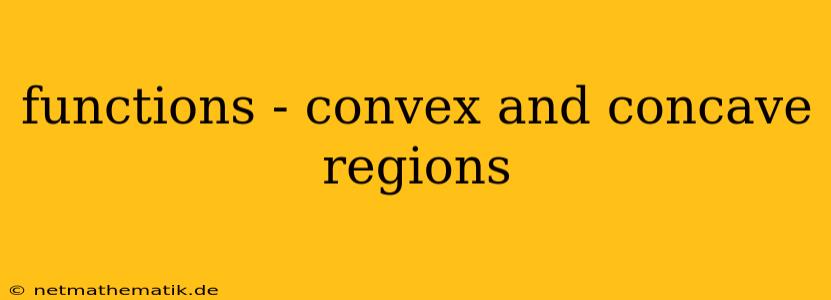In the realm of mathematics, particularly calculus, the concept of functions plays a pivotal role in understanding and describing relationships between variables. One crucial aspect of function analysis is the identification of convex and concave regions, which offer valuable insights into the function's behavior and its potential applications. This article delves into the intricacies of convex and concave regions of functions, exploring their definitions, properties, and practical implications.
Understanding Convex and Concave Functions
A convex function is a function where a line segment connecting any two points on the function's graph lies above or on the graph itself. Conversely, a concave function is one where the line segment connecting any two points on the graph lies below or on the graph. To visualize this, consider a simple example:
- Convex: The function f(x) = x^2 is convex because for any two points on its graph, the line segment connecting them always lies above the graph.
- Concave: The function f(x) = -x^2 is concave because for any two points on its graph, the line segment connecting them always lies below the graph.
Identifying Convex and Concave Regions
To determine whether a function is convex or concave, we can employ a couple of methods:
1. First Derivative Test
This method relies on the first derivative of the function. If the first derivative is increasing over a particular interval, the function is convex in that interval. Conversely, if the first derivative is decreasing over an interval, the function is concave in that interval.
- Convex: If f'(x) is increasing, then f(x) is convex.
- Concave: If f'(x) is decreasing, then f(x) is concave.
2. Second Derivative Test
The second derivative test provides a more straightforward approach to identifying convex and concave regions. If the second derivative is positive over an interval, the function is convex in that interval. Conversely, if the second derivative is negative over an interval, the function is concave in that interval.
- Convex: If f''(x) > 0, then f(x) is convex.
- Concave: If f''(x) < 0, then f(x) is concave.
Practical Implications of Convex and Concave Regions
The identification of convex and concave regions has significant practical implications in various fields, including:
- Optimization: Convex functions play a crucial role in optimization problems. For instance, in a convex optimization problem, any local minimum is also a global minimum. This property is essential for finding optimal solutions in various applications, such as engineering, economics, and machine learning.
- Economics: In economics, convex and concave functions are widely used to model utility functions and production functions. For example, a concave utility function implies that the marginal utility of a good decreases as consumption increases.
- Statistics: Convex functions are employed in statistical analysis for tasks like maximum likelihood estimation, where finding the maximum of a likelihood function is often a convex optimization problem.
- Machine Learning: Convex and concave functions are fundamental in machine learning algorithms. For instance, in support vector machines (SVMs), the objective function is often convex, enabling efficient optimization of the model parameters.
Conclusion
The concept of convex and concave regions is a cornerstone in the understanding and analysis of functions. By determining whether a function is convex or concave over specific intervals, we gain crucial insights into its behavior and potential applications. From optimization problems to economic modeling and machine learning, the identification of convex and concave regions serves as a powerful tool for exploring and harnessing the properties of functions. Understanding these concepts opens doors to a deeper appreciation of mathematical analysis and its vast applications in various fields.
